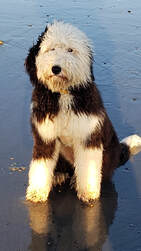 Izzie is our model for this blog.
Izzie is our model for this blog. Dogs neither understand English nor read minds. It is the dog owner's and trainer's job to break commands down into parts which can be taught well, and then advance the command by increasing things like the three Ds (duration, distance and distraction), which was discussed in our previous blog post.
There are many ways to start a command, but for the purposes of this example, I will show the abbreviated steps of a lured down command. To me a lured down command is started with a small training treat or piece of kibble being used to lure your puppy or dog into position.
Steps in a Lured Down Command:
NOTE: You would have typically already started the lured sit command. So first I lure into a sit or if they are already sitting and waiting, I start from there. Also each of these steps may take a week or more to achieve. You don't want to do any of the steps sloppily and not finish them, because you will leave holes in your training. Training holes leads to being frustrated, where training with more care actually gets you to where you want faster, because you don't need to double back.
- While they are in a sit, hold the treat at their nose (typically for puppies especially), and then bring the treat slowly down and forward (you may want differently position the treat if you are thinking about dog obedience competitions in the future). Note that commands are not used until the performance is frequent enough so that we can name the command. Usually the handler is down on the ground to be closer to the puppy or not so tall dog. Have this step so eventually it is easily done with treat at their nose. (this might take a week, especially with a very young puppy)
- Once step two can be done easily, the dog owner begins to say the command beforehand while they stand and lure with the treat more distant from the dog's nose. At this point, we are working to where the dog begins to respond to the command before or as the treat begins it's lure. Once the dog is not so dependent on the treat being lured down, you are ready to go onto the next step. I like to focus on getting the performance I want four in a row out of five times easily before moving on.
- Typically, this next step is spent working on being totally upright and not having to lure the dog into a down. So the result of the end of this, is that you want to be standing straight up, give the command, and your dog go into a down (this is close to you at this point, we have not started the three Ds in this example). The dog owner does this by progressing bit by bit of bending into less and less of a lured position, and being able to get four in a row at each different posture until moving more upright for the next session.
- Once you can easily give the "down command" upright four times in a row, then it is time to layer many things on top of it like the 3 Ds and changing of environments. These all have their own unique steps.
 RSS Feed
RSS Feed